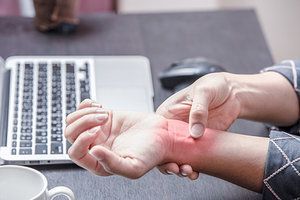When we talk about fertility, the focus is often placed on the ovaries and the uterus. Yet sperm-related factors contribute to nearly half of all cases of infertility. Whether someone is navigating fertility care alone or with a partner, and whether building a family through intercourse, IVI, IUI or IVF, it’s vital to include sperm health in the picture.
Acupuncture for Carpal Tunnel
Statistical data indicates that "Carpal tunnel syndrome is the most common peripheral nerve entrapment syndrome worldwide."1 About three percent of the adult population suffers from it. Women tend to have it three times more often than men, and its severity progresses with age.
Carpal Tunnel Research
Latest research studies report that, "Carpal tunnel syndrome is now a well-understood clinical phenomenon in which neuropathic symptoms are secondary to median nerve compression within the carpal tunnel."2 Nonetheless, however, carpal tunnel syndrome "leads to more disability than most other upper extremity disorders."3 Jennifer Wipperman and Kyle Goerl described diagnosis and treatment of the syndrome in great detail in their article "Carpal Tunnel Syndrome: Diagnosis and Management" in the American Family Physician.4
Regarding diagnosis, they write that patients who suffer from carpal tunnel syndrome experience pain and paresthesias along the median nerve's pathway, particularly in "the palmar aspect of the thumb, index and middle fingers, and radial half of the ring finger." To ensure that the diagnosis is correct, the authors recommend a few neurological tests, "such as the flick sign, Phalen maneuver, and median nerve compression test," which need to be positive.

The authors write that if patients exhibit typical symptoms and signs of carpal tunnel syndrome, they do not need additional testing. If patients' symptoms and signs are atypical, however, then "ultrasonography and electrodiagnostic studies are useful to confirm the diagnosis in atypical cases and rule out other causes." Regarding treatment, they write, "Conservative treatment may be offered initially to patients with mild to moderate carpal tunnel syndrome. Options include splinting, corticosteroids, physical therapy, therapeutic ultrasound, and yoga."4
Curiously, the authors mention physical therapy and yoga as possible treatment options, but they do not mention acupuncture. Is it an oversight, or are there reasons for not including acupuncture as a possible treatment modality? One recent paper reviews 12 high-quality studies and concludes that "Acupuncture and laser acupuncture may have little or no effect in the short term on symptoms of Carpal Tunnel Syndrome in comparison with placebo or sham acupuncture."5
We have reasons to believe that the main reason for such low success rate is because it is considered to be the norm in mainstream modern acupuncture to use point selections recommended by textbooks, instead of relying on the Four Examinations before all other diagnostic procedures. In our experience, careful observation and palpation often lead to unexpected discoveries, which can result in highly effective acupuncture treatment. Let us illustrate what we mean using three typical case studies.
Case Study #1
A right-handed 44-year-old woman with a complaint of weakness of the fingers of her right hand and shooting pain from her right wrist into her right hand and thumb, index, and ring fingers during wrist flexion or extension for the past six months. Her symptoms had been becoming increasingly more intense during the last two months.
Our initial instinct was to use classical, widely accepted acupuncture point combination that appear in most textbooks, but palpation of the patient's right wrist revealed no tender points. There was no swelling in the wrist area, and passive flexion and extension produced only mild discomfort. Interestingly enough, the flick sign, Phalen maneuver, and median nerve compression test were all slightly positive, causing only mild pain and discomfort. Considering the severity of the patient's symptoms, there must have been something else going on that was causing the clear carpal tunnel symptoms.
While flexing and extending the patient's wrist, we noticed unusual protrusions in the patient's right forearm, in the area of the extensor compartment. We began palpating those areas, which were between the radius and ulna, about two finger-breadths proximal to the radial and ulnar styloid processes. The palpation revealed muscle spasms deep between the bones, but more important was that light-to-moderate pressure on the local points in that region reproduced the woman's symptoms.
We inserted 12 one-inch 38-gauge needles in the posterior forearm with minimal stimulation, because the points were very sensitive, and left them for 15 minutes. When she returned two days later, the woman reported that her symptoms had become milder and that hand had begun to feel stronger. Palpation revealed that the spasm became softer in the insertion site but remained firm in other adjacent areas. We, again, inserted about a dozen thin needles in the firmest—not most painful—points in the forearm and left them there for 15 minutes. When the patient came back a few days later, she reported that some flexion angles stopped hurting. After two more sessions that involved the identical strategy, tight points were increasingly more difficult to find, and so was reproduction of her symptoms using palpation. The woman stopped by our office a month later to say that her hand felt fine.
Case Study #2
A 51-year-old right-handed man, who worked as a computer programmer, reported periodic shooting pain from his wrist to his right index finger and thumb. There was a similar but much milder pain in his left hand for the past two months. In this case, too, palpation revealed no inflammation in the wrist joint, but the flick sign, Phalen maneuver, and median nerve compression test were all mildly positive.
Observation of the forearm during passive flexion and extension did not reveal any abnormalities, although the patient reported feeling mild discomfort during it, but palpation revealed some useful information. The finger extensors of the right index finger and thumb had no knots on them, but the tone was greater than that of the neighboring muscles. The muscle tone was only slightly greater in the neighborhood of LI 6, gradually increasing until it reached LI 10, where it was the tightest and most painful. The area felt slightly warmer to the touch than the neighboring tissues, suggesting of local inflammation. Curiously, LI 11 felt absolutely unremarkable on both arms.
We inserted 15 38-gauge needles along the tighter muscles; the tightest and most sensitive were the areas of LI 9 and LI 10. The patient could tolerate only mild stimulation in all the points with the exception of LI10. The muscle tone began normalizing after the first three sessions, but at the same time the patient began working longer hours, showing up for treatments less often, and the muscle tone along with the inflammation and pain returned.
It took seven months of acupuncture treatments, whose frequency fluctuated from once every four weeks to two times a week, for the muscle tone to become similar to that of the neighboring muscles, and by that time the patient's pain had disappeared.
Case Study #3
A 32-year-old right-handed woman with a carpal tunnel syndrome in her right wrist reported feeling frequent pain in both of her forearms. The woman could not pinpoint the pain's exact location. Curiously enough, she reported experiencing more pain at rest and at night than during the day. Her primary-care physician suspected fibromyalgia—in addition to her carpal-tunnel syndrome—and recommended to try acupuncture.
Visually, her arms were unremarkable. Palpation of the superficial muscles brought no useful findings. Palpation of the anterior forearm, however, revealed spasm light-to-moderate pressure on which reproduced the same difficult-to-locate pain that was the reason for her visit. Inserting 38-gauge one-inch needles in the tightest areas of the spasm dissipated it during nine sessions that occurred during a period of two months, and the patient reported that the pain had disappeared with it.
In the first and second cases, the patients' symptoms were most likely produced by overuse of their fingers. What was interesting was that the neurological tests that were used to diagnose their carpal-tunnel syndrome were positive. Hypothetically, if a nerve passes near a wrist joint is already inflamed, then stretching or compressing it would create symptoms similar to those produced by the carpal tunnel syndrome. In the third case, the cause of pain might have been hand and arm overuse or holding the forearm on a glass or metal table surface for days, months, or even years in a row, causing soft tissue constriction, nerve compression, and eventually pain.
In our experience, many patients who were diagnosed with having carpal tunnel syndrome, in reality experience referred pain from their proximal forearms. Researchers suspect that not all carpal tunnel syndrome cases are correct diagnoses6 and that even diagnostic nerve conduction testing can lead to mistaken results.7 In research studies, scientists usually use nerve conduction studies to test the effectiveness such manual tests as the flick sign, Phalen maneuver, and median nerve compression test,8 none of which detects the exact location of nerve entrapment. Finding the exact locations of the median (and sometimes other large nerves of the forearm) can lead to successful acupuncture treatments.
What we found to be essential in the cases described above as well as many similar cases was the type of palpation used. Oftentimes, acupuncturists palpate by pressing down vertically to the surface of the skin. While this type of palpation is popular, it provides only limited amount of information. Light-pressure pinch-like type of palpation can create a much clearer picture of the problem and its causes and is crucial in finding effective acupuncture points in each individual case.9
No matter how definitive the results of a test are in the patients with carpal tunnel syndrome, careful examination of each individual patient is crucial. Whether you find something new or simply confirm an already established diagnosis, you would be collecting evidence of an individual patient's condition. And even if the real cause of the problem might remain a mystery, you will have more firsthand information and thus greater chances of finding an effective treatment in each individual case, than you would by merely blindly applying methods and techniques described in textbooks. As a result, slight modifications to acupuncture point selection and stimulation according to specific findings can greatly increase the treatment's success rate.
References
- Padua L, Coraci D, et al. Carpal tunnel syndrome: clinical features, diagnosis, and management. The Lancet Neurology, 2016;15(12), 1273-1284.
- Cooke ME, Duncan SF. Carpal Tunnel Syndrome and Related Median Neuropathies, History of Carpal Tunnel Syndrome (pp. 7-11). New York: Springer, Cham, 2017.
- Adamson CH, Eisen, et al. S02-4 Personal, psychosocial, and biomechanical risk factors for work disability from carpal tunnel syndrome: a pooled prospective study. Symposium 2 – Longitudinal Analyses of Workplace Distal Upper Limb Disorders: Findings from the NIOSH Consortium Studies, 2016.
- Wipperman, J., & Goerl, K. (2016). Carpal Tunnel Syndrome: Diagnosis and Management. American family physician, 94(12).
- Choi, G. H., Wieland, L. S., Lee, H., Sim, H., Lee, M. S., & Shin, B. C. (2018). Acupuncture and related interventions for the treatment of symptoms associated with carpal tunnel syndrome. Cochrane Database of Systematic Reviews, (12).
- Schick, C. W., & Kaplan, F. T. D. (2017). Differential Diagnosis of Carpal Tunnel Syndrome. In Carpal Tunnel Syndrome and Related Median Neuropathies (pp. 39-49). Springer, Cham.
- Ring, D. C. (2016). Clinical faceoff: routine electrodiagnostic testing is not helpful in the management of carpal tunnel syndrome. Clinical Orthopaedics and Related Research, 474(8), 1770-1774.
- Bruske, J., Bednarski, M., Grzelec, H., & Zyluk, A. (2002). The usefulness of the Phalen test and the Hoffmann-Tinel sign in the diagnosis of carpal tunnel syndrome. Acta orthopaedica belgica, 68(2), 141-145.
- Shudo, D. & Brown, S. (tr). Finding Effective Acupuncture Points. 1st ed. Seattle: Eastland Press; 2003.
Resource
- Ashworth, N. L. (2016). Carpal tunnel syndrome. American Family Physician, 94(10), 830-831.



